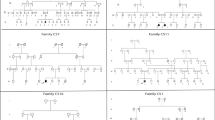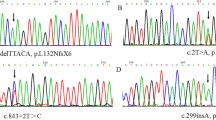Abstract
Background
Cockayne syndrome is an inherited heterogeneous defect in transcription-coupled DNA repair (TCR) cause severe clinical syndromes, which may affect the nervous system development of infants and even lead to premature death in some cases. ERCC8 diverse critical roles in the nucleotide excision repair (NER) complex, which is one of the disease-causing genes of Cockayne syndrome.
Methods and results
The mutation of ERCC8 in the patient was identified and validated using WES and Sanger sequencing. Specifically, a compound heterozygous mutation (c.454_460dupGTCTCCA p. T154Sfs*13 and c.755_759delGTTTT p.C252Yfs*3) of ERCC8 (CSA) was found, which could potentially be the genetic cause of Cockayne syndrome in the proband.
Conclusion
In this study, we identified a novel heterozygous mutation of ERCC8 in a Chinese family with Cockayne syndrome, which enlarging the genetic spectrum of the disease.



Similar content being viewed by others
Data availability
Data sharing is not applicable to this article as no new data were created or analyzed in this study.
References
Cockayne EA (1936) Dwarfism with retinal atrophy and deafness. Arch Dis Child 11(61):1–8
Spitz MA, Severac F, Obringer C, Baer S, Le May N, Calmels N, Laugel V (2021) Diagnostic and severity scores for Cockayne syndrome. Orphanet J Rare Dis 16(1):63
Carroll J, Pabst L, Koboldt DC, Franklin SJ, Choi S, Wilson RK, Lo W (2023) Novel presentation of hemiplegic migraine in a patient with Cockayne Syndrome. Pediatr Neurol 138:95–97
Wang X, Li Y, Zhao A, Wang Y, Cao Q, Pan C, Li M (2023) Next-generation sequencing through multi-gene panel testing for the diagnosis of a Chinese patient with atypical Cockayne syndrome. Mol Genet Genom Med 11:e2254
Gauhar Z, Tejwani L, Abdullah U, Saeed S, Shafique S, Badshah M, Choi J, Dong W, Nelson-Williams C, Lifton RP et al (2022) A Novel Missense Mutation in ERCC8 Co-Segregates with Cerebellar Ataxia in a Consanguineous Pakistani Family. Cells 11(19):3090
Marteijn JA, Lans H, Vermeulen W, Hoeijmakers JHJ (2014) Understanding nucleotide excision repair and its roles in cancer and ageing. Nat Rev Mol Cell Biol 15(7):465–481
Spivak G (2015) Nucleotide excision repair in humans. DNA Repair (Amst) 36:13–18
Fan LL, Liu JS, Huang H, Du R, Xiang R (2019) Whole exome sequencing identified a novel mutation (p.Ala1884Pro) of beta-spectrin in a Chinese family with hereditary spherocytosis. J Gene Med 21(2–3):e3073
Kokic G, Wagner FR, Chernev A, Urlaub H, Cramer P (2021) Structural basis of human transcription-DNA repair coupling. Nature 598(7880):368–372
Khayat M, Hardouf H, Zlotogora J, Shalev SA (2010) High carriers frequency of an apparently ancient founder mutation p.Tyr322X in the ERCC8 gene responsible for Cockayne syndrome among christian arabs in Northern Israel. Am J Med Genet A 152A(12):3091–3094
ZHANG Xiaoli CM, Xiaoli LI, Rui HAN, Lijun WANG, Panpan SONG, Ling GAN, Guohui NIU, Tianming JIA (2021) Two siblings of type 1 Cockayne syndrome caused by a new compound heterozygous mutation of ERCC8 gene. Chin J Birth Health Heredity 10:1458–1461
Li D, Roberts R (2001) WD-repeat proteins: structure characteristics, biological function, and their involvement in human diseases. Cell Mol Life Sci 58(14):2085–2097
Qiang M, Khalid F, Phan T, Ludwig C, Scharffetter-Kochanek K, Iben S (2021) Cockayne syndrome-associated CSA and CSB mutations impair ribosome biogenesis, ribosomal protein stability, and global protein folding. Cells 10(7):1616
Hao X-D, Yao Y-Z, Xu K-G, Dong B, Xu W-H, Zhang J-J (2022) Insufficient dose of ERCC8 protein caused by a Frameshift mutation is Associated with Keratoconus with congenital cataracts. Investig Ophthalmol Vis Sci 63(13):1
Chebly A, Corbani S, Abou Ghoch J, Mehawej C, Megarbane A, Chouery E (2018) First molecular study in Lebanese patients with Cockayne syndrome and report of a novel mutation in ERCC8 gene. BMC Med Genet 19(1):161
Gu Y, Bhatta AK, Du X, Shao M, Keyal U, Zhang G, Hua Y (2017) Identification of one Novel complex delins mutation and one recurrent mutation of ERCC8 gene in a Chinese family with Cockayne Syndrome A. J Eur Acad Dermatol Venereol 31(9):e394–e395
Acknowledgements
We thank the patients and their family members for their participation in this study and all patient advisers for their assistance in clinical examination and blood specimen collection.
Funding
This work was supported by the Clinical Medical Personnel Training Program of Hebei Provincial Health Commission (Ya-Li Li), Inner Mongolia Science and Technology Innovation Guidance Project (NM-KJCXYD-018), Innovation Foundation for Postgraduate of Central South University (1053320220863) and the Fundamental Research Funds for Central Universities of Central South University (2023ZZTS0863).
Author information
Authors and Affiliations
Contributions
Meng-Wei Liu contributed to sequencing analysis and functional verification. Cheng-Feng Hu contributed to variant interpretation and sequencing analysis. Jie-Yuan Jin contributed to recruiting samples and collecting clinical phenotypes. Rong Xiang and Liang-liang Fan contributed to designing experiments, raising the idea of the project, and reviewing and editing the draft. Ya-Li Li and Lei Zhu contributed to supervision, project administration, and reviewing and editing the draft.
Corresponding authors
Ethics declarations
Conflict of interest
The authors declare no conflicts of interest.
Ethical approval
This study complied with the tenets of the Declaration of Helsinki and was approved by the Ethics Committee of the Hebei General Hospital. Written informed consent was obtained from the parents.
Additional information
Publisher’s Note
Springer Nature remains neutral with regard to jurisdictional claims in published maps and institutional affiliations.
Rights and permissions
Springer Nature or its licensor (e.g. a society or other partner) holds exclusive rights to this article under a publishing agreement with the author(s) or other rightsholder(s); author self-archiving of the accepted manuscript version of this article is solely governed by the terms of such publishing agreement and applicable law.
About this article
Cite this article
Liu, MW., Hu, CF., Jin, JY. et al. A compound heterozygous mutation of ERCC8 is responsible for a family with Cockayne syndrome. Mol Biol Rep 51, 371 (2024). https://doi.org/10.1007/s11033-024-09235-9
Received:
Accepted:
Published:
DOI: https://doi.org/10.1007/s11033-024-09235-9




